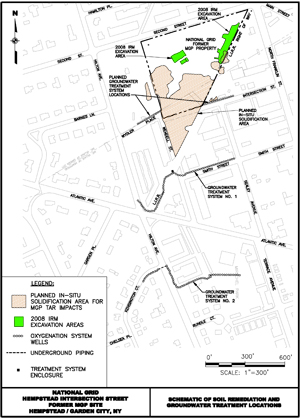

Following are the steps most often required by the New York State Department of Environmental Conservation in the investigation and remediation of a former MGP site.
Remedial Investigation/Feasibility Study
Interim Remedial Measures
Record of Decision (or Decision Document)
Remedial Design
Remedial Construction
The Hempstead Intersection Street project is now in the Construction phase, implementing the final elements of the Remedial Action Plan that was selected by the NYSDEC in the Record of Decision.
Remedial Investigation Summary:
 National Grid (formerly KeySpan) began a Remedial Investigation of the Hempstead IS site in 2000 under an Order on Consent with the New York State Department of Environmental Conservation (NYSDEC). Supplemental Remedial Investigation work was performed in 2003 and 2004 to further define the extent of contamination on the site, on adjacent properties and the off-site groundwater plume. The supplemental work included a private groundwater well survey distributed to over 400 property owners. Based upon subsequent discussion with the NYSDEC and NYSDOH, a groundwater Capture Zone Analysis (CZA) was also performed to verify that there were no anticipated effects from the Site on local water supply wells. This CZA was completed in the 2005-2006 timeframe during which time there were also other NYSDEC/NYSDOH comment/review cycles conducted in order to complete the Remedial Investigation Report.
National Grid (formerly KeySpan) began a Remedial Investigation of the Hempstead IS site in 2000 under an Order on Consent with the New York State Department of Environmental Conservation (NYSDEC). Supplemental Remedial Investigation work was performed in 2003 and 2004 to further define the extent of contamination on the site, on adjacent properties and the off-site groundwater plume. The supplemental work included a private groundwater well survey distributed to over 400 property owners. Based upon subsequent discussion with the NYSDEC and NYSDOH, a groundwater Capture Zone Analysis (CZA) was also performed to verify that there were no anticipated effects from the Site on local water supply wells. This CZA was completed in the 2005-2006 timeframe during which time there were also other NYSDEC/NYSDOH comment/review cycles conducted in order to complete the Remedial Investigation Report.
The Key Findings of the Final Remedial Investigation Report, as summarized in the NYSDEC Fact Sheet announcing the acceptance of that Report, are:
1. The investigation found the presence of materials typically associated with MGPs, including BTEX (benzene, toluene, ethylbenzene and xylene), PAH’s (polycyclic aromatic hydrocarbons), and total cyanide. These wastes were found in soil and groundwater. Most were found in shallow soils in the upper 8 feet of the site near where MGP operations were located, and/or in a zone approximately 24-34 feet below grade both on and off-site.
2. There is a plume of groundwater containing BTEX and PAHs, flowing generally south from the site. It is about 600 feet wide and extends for about 3,800 feet. It is at a depth of between approximately 24 and 30 feet beneath the ground surface. The concentrations of BTEX and the PAHs diminish as the plume migrates away from the site, primarily because of natural attenuation. The investigation also found other local non-MGP, non-KeySpan related source contributors for BTEX and PAH’s which are outside of KeySpan’s control. The area of the groundwater plume is bounded approximately by Second Street to the North, Sealy and Terrace Avenue to the East, Hilton Avenue, Kensington Court and Cathedral Avenue to the West, and Front Street to the South.
3. The Remedial Investigation determined that chemical constituents from the site have not adversely impacted the drinking water supply wells serving the communities, and are not expected to adversely affect those wells based on anticipated pumping rates.
4. There are no current complete pathways through which people on or near the site are exposed to hazardous materials, but there are potential exposure pathways that will be mitigated as part of the Site remediation.
5. A Remedial Action Plan and Interim Remedial Measures approved for the site will eliminate potential pathways.
Interim Remedial Measures and Remedial Action Plan
Interim Remedial Measures (IRMs)Several Interim Remedial Measures, which were approved by the NYSDEC in November 2007, have been completed at the site. The IRMs include installation of wells to recover liquid tars from the deep sub-surface (completed in early 2008); IRM-related excavations also completed in 2008 which removed approximately 7,000 cubic yards of coal tar-contaminated soil from several locations in the northern and eastern areas of the site; and the installation in 2010-2011 of two groundwater oxygenation systems in offsite locations south of the site to accelerate the reduction of contaminant concentrations in the underground groundwater plume. Detailed information about these IRMs can be found in the Key Documents section of this website, in both the Major Reports and Fact Sheets sub-tabs.
Remedial Action Plan (RAP)
The Remedial Action Plan (RAP) builds on the IRMs with additional source removal excavation and In-Situ Solidification (ISS) of contaminated soils that are located deeper below the ground surface.
Following the community fact sheet distribution, and the NYSDEC public availability Session in September of 2011, National Grid’s Contractor started mobilizing to the Site in October 2011 for the final major phase of implementation of the Site RAP. The work will be done on property owned by National Grid as well as on off-site properties. There are two elements to this phase which follows the on-site IRM that was completed in 2008. The first includes excavation of shallow soils, and the use of a technology known as In-Situ Solidification (or ISS) to encapsulate the soil contamination that is located on site and in nearby off-site areas; the second element includes installation of two additional off-site oxygenation treatment systems - one on Wydler Place and another along Intersection Street. The oxygenation systems will be used to help accelerate the reduction of groundwater contaminant concentrations from the site.
The ISS process uses large diameter augers to mix contaminated soil with concrete additives to permanently bind the contaminants underground within a concrete based mass, and then the ISS mass will be covered with clean fill. The process begins with off-site excavations to approximately 10-15 feet below ground surface for properties not owned by National Grid, followed by on-site excavations to approximately 5-10 feet below ground surface within National Grid's property. Clean excavated soil will be stockpiled and controlled on the National Grid property to re-use for backfilling the remediation areas. Following the excavation, large auger rigs will be used for the ISS to mix cement-based reagents with the contaminated soils to solidify the contaminants in place within the cement based mixture. After completing the excavations and the solidification work in each remediation area, the clean stockpiled excavated soil will be placed back into the excavated areas and the areas will be restored. The project, including the installation of the two oxygen system lines, is expected to take about two years to complete.
National Grid, the NYSDEC and the state and local health agencies have developed plans to minimize potential impacts to the community. For the ISS, the truck traffic will follow the same plan and routes that were used successfully during the 2008 excavation project. Truck traffic leaving the site will alternate the use of north and south trucking routes every other week. The upcoming ISS related excavation and ISS work can generate noise and odor, but noise and odor levels will be monitored and there are mitigation plans in place if conditions are observed approaching the conservative action levels. A Community Air Monitoring Program (CAMP) will be in place for all intrusive activities, and requires mitigation measures or work stoppages before airborne concentrations approach conservative action levels.
